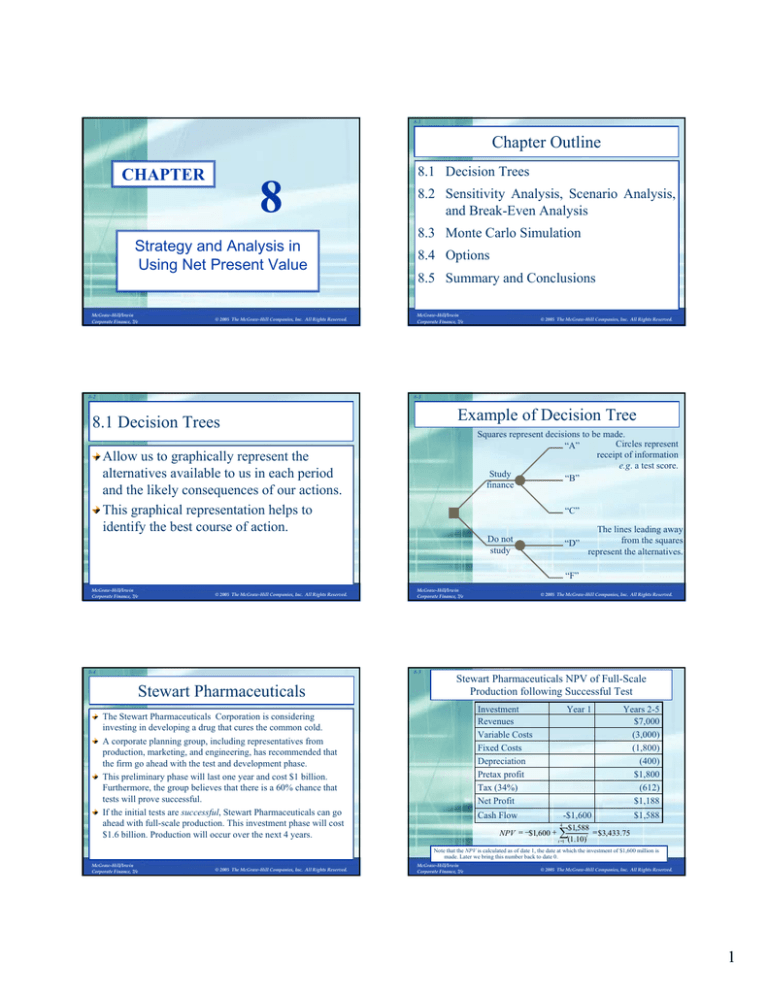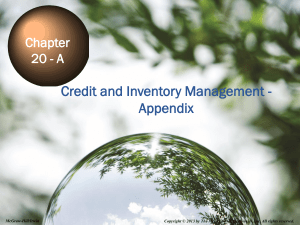
8-0
8-1
Chapter Outline
8.1 Decision Trees
CHAPTER
8
Strategy and Analysis in
Using Net Present Value
McGraw-Hill/Irwin
Corporate Finance, 7/e
© 2005 The McGraw-Hill Companies, Inc. All Rights Reserved.
8-2
8.2 Sensitivity Analysis, Scenario Analysis,
and Break-Even Analysis
8.3 Monte Carlo Simulation
8.4 Options
8.5 Summary and Conclusions
McGraw-Hill/Irwin
Corporate Finance, 7/e
© 2005 The McGraw-Hill Companies, Inc. All Rights Reserved.
8-3
Example of Decision Tree
8.1 Decision Trees
Squares represent decisions to be made.
Circles represent
“A”
receipt of information
e.g. a test score.
Study
“B”
finance
Allow us to graphically represent the
alternatives available to us in each period
and the likely consequences of our actions.
This graphical representation helps to
identify the best course of action.
“C”
Do not
study
The lines leading away
from the squares
represent the alternatives.
“D”
“F”
McGraw-Hill/Irwin
Corporate Finance, 7/e
© 2005 The McGraw-Hill Companies, Inc. All Rights Reserved.
8-4
McGraw-Hill/Irwin
Corporate Finance, 7/e
8-5
Stewart Pharmaceuticals
© 2005 The McGraw-Hill Companies, Inc. All Rights Reserved.
Stewart Pharmaceuticals NPV of Full-Scale
Production following Successful Test
Investment
Revenues
Variable Costs
Fixed Costs
Depreciation
Pretax profit
Tax (34%)
Net Profit
The Stewart Pharmaceuticals Corporation is considering
investing in developing a drug that cures the common cold.
A corporate planning group, including representatives from
production, marketing, and engineering, has recommended that
the firm go ahead with the test and development phase.
This preliminary phase will last one year and cost $1 billion.
Furthermore, the group believes that there is a 60% chance that
tests will prove successful.
If the initial tests are successful, Stewart Pharmaceuticals can go
ahead with full-scale production. This investment phase will cost
$1.6 billion. Production will occur over the next 4 years.
Year 1
Cash Flow
Years 2-5
$7,000
(3,000)
(1,800)
(400)
$1,800
(612)
$1,188
-$1,600
NPV = −$1,600 +
4
∑(1.10)
t =1
$1,588
t
$1,588
= $3,433.75
Note that the NPV is calculated as of date 1, the date at which the investment of $1,600 million is
made. Later we bring this number back to date 0.
McGraw-Hill/Irwin
Corporate Finance, 7/e
© 2005 The McGraw-Hill Companies, Inc. All Rights Reserved.
McGraw-Hill/Irwin
Corporate Finance, 7/e
© 2005 The McGraw-Hill Companies, Inc. All Rights Reserved.
1
8-6
8-7
Stewart Pharmaceuticals NPV of Full-Scale Production
following Unsuccessful Test
Investment
Revenues
Variable Costs
Fixed Costs
Depreciation
Pretax profit
Tax (34%)
Net Profit
Cash Flow
Year 1
NPV = −$1,600 +
∑ (1.10)
$475.90
t
t =1
The firm has two decisions to make:
Invest
To test or not to test.
To invest or not to invest.
Years 2-5
$4,050
(1,735)
(1,800)
(400)
$115
(39.10)
$75.90
$475
-$1,600
4
Decision Tree for Stewart Pharmaceutical
Test
Do not
invest
= −$91.461
© 2005 The McGraw-Hill Companies, Inc. All Rights Reserved.
8-8
NPV = $0
Failure
Do not
test
Note that the NPV is calculated as of date 1, the date at which the investment of $1,600 million is made. Later
we bring this number back to date 0.
McGraw-Hill/Irwin
Corporate Finance, 7/e
NPV = $3.4 b
Success
McGraw-Hill/Irwin
Corporate Finance, 7/e
NPV = $0
NPV = –$91.46 m
Invest
© 2005 The McGraw-Hill Companies, Inc. All Rights Reserved.
8-9
8.3 Sensitivity Analysis, Scenario Analysis,
and Break-Even Analysis
Stewart Pharmaceutical: Decision to Test
Let’s move back to the first stage, where the decision
boils down to the simple question: should we invest?
The expected payoff evaluated at date 1 is:
Allows us to look the behind the NPV
number to see firm our estimates are.
When working with spreadsheets, try to
build your model so that you can just adjust
variables in one cell and have the NPV
calculations key to that.
⎞ ⎛ Prob.
Expected ⎛ Prob.
Payoff
Payoff ⎞
⎟⎟ + ⎜⎜
⎟⎟
= ⎜⎜
×
×
payoff
⎝success given success ⎠ ⎝failure given failure ⎠
Expected
= (.60 ×$3,433.75 ) + (.40 ×$0 ) = $2,060.25
payoff
The NPV evaluated at date 0 is:
NPV = −$1,000 +
$2,060.25
= $872.95
1.10
So we should test.
McGraw-Hill/Irwin
Corporate Finance, 7/e
© 2005 The McGraw-Hill Companies, Inc. All Rights Reserved.
8-10
McGraw-Hill/Irwin
Corporate Finance, 7/e
© 2005 The McGraw-Hill Companies, Inc. All Rights Reserved.
8-11
Sensitivity Analysis: Stewart
Pharmaceuticals
We can see that NPV is very sensitive to changes in revenues. In
the Stewart Pharmaceuticals example, a 14% drop in revenue
leads to a 61% drop in NPV
% ∆Rev =
$6,000 −$7,000
= −14.29%
$7,000
$1,341.64 − $3,433.75
= −60.93%
% ∆NPV =
$3,433.75
For every 1% drop in revenue we can expect roughly a 4.25%
drop in NPV
4.25 =
McGraw-Hill/Irwin
Corporate Finance, 7/e
− 60.93%
14.29%
© 2005 The McGraw-Hill Companies, Inc. All Rights Reserved.
Scenario Analysis: Stewart
Pharmaceuticals
A variation on sensitivity analysis is scenario analysis.
For example, the following three scenarios could apply
to Stewart Pharmaceuticals:
1. The next years each have heavy cold seasons, and sales
exceed expectations, but labor costs skyrocket.
2. The next years are normal and sales meet expectations.
3. The next years each have lighter than normal cold seasons, so
sales fail to meet expectations.
Other scenarios could apply to FDA approval for their
drug.
For each scenario, calculate the NPV.
McGraw-Hill/Irwin
Corporate Finance, 7/e
© 2005 The McGraw-Hill Companies, Inc. All Rights Reserved.
2
8-12
8-13
8.4 Options
Options
The Option to Expand
One of the fundamental insights of modern
finance theory is that options have value.
The phrase “We are out of options” is
surely a sign of trouble.
Because corporations make decisions in a
dynamic environment, they have options
that should be considered in project
valuation.
McGraw-Hill/Irwin
Corporate Finance, 7/e
© 2005 The McGraw-Hill Companies, Inc. All Rights Reserved.
8-14
Has value if demand turns out to be higher than
expected.
The Option to Abandon
Has value if demand turns out to be lower than
expected.
The Option to Delay
Has value if the underlying variables are changing
with a favorable trend.
McGraw-Hill/Irwin
Corporate Finance, 7/e
© 2005 The McGraw-Hill Companies, Inc. All Rights Reserved.
8-15
Campusteria pro forma Income Statement
The Option to Expand
Investment
Imagine a start-up firm, Campusteria, Inc. which plans
to open private (for-profit) dining clubs on college
campuses.
The test market will be your campus, and if the concept
proves successful, expansion will follow nationwide.
Nationwide expansion, if it occurs, will occur in year
four.
The start-up cost of the test dining club is only $30,000
(this covers leaseholder improvements and other
expenses for a vacant restaurant near campus).
McGraw-Hill/Irwin
Corporate Finance, 7/e
© 2005 The McGraw-Hill Companies, Inc. All Rights Reserved.
8-16
Year 0
Revenues
Years 1-4
$60,000
Variable Costs
($42,000)
Fixed Costs
($18,000)
Depreciation
($7,500)
Pretax profit
($7,500)
Tax shield 34%
$2,550
Net Profit
Cash Flow
–$4,950
–$30,000
4
Variable costs are
projected to be $3,500
per month.
Fixed costs (the lease
payment) are projected
to be $1,500 per month.
$2,550
$2,550
= −$21,916.84
NPV = −$30,000 + ∑
t
t =1 (1.10)
McGraw-Hill/Irwin
Corporate Finance, 7/e
We plan to sell 25 meal
plans at $200 per month
with a 12-month contract.
We can depreciate our
capitalized leaseholder
improvements.
© 2005 The McGraw-Hill Companies, Inc. All Rights Reserved.
8-17
The Option to Expand:
Valuing a Start-Up
Note that while the Campusteria test site has a
negative NPV, we are close to our break-even level
of sales.
If we expand, we project opening 20 Campusterias in
year four.
The value of the project is in the option to expand.
If we hit it big, we will be in a position to score
large.
We won’t know if we don’t try.
McGraw-Hill/Irwin
Corporate Finance, 7/e
© 2005 The McGraw-Hill Companies, Inc. All Rights Reserved.
Discounted Cash Flows and Options
We can calculate the market value of a project as the
sum of the NPV of the project without options and the
value of the managerial options implicit in the project.
M = NPV + Opt
A good example would be comparing the desirability of
a specialized machine versus a more versatile machine.
If they both cost about the same and last the same
amount of time the more versatile machine is more
valuable because it comes with options.
McGraw-Hill/Irwin
Corporate Finance, 7/e
© 2005 The McGraw-Hill Companies, Inc. All Rights Reserved.
3
8-18
8-19
The Option to Abandon: Example
The Option to Abandon: Example
Suppose that we are drilling an oil well. The
drilling rig costs $300 today and in one year the
well is either a success or a failure.
The outcomes are equally likely. The discount
rate is 10%.
The PV of the successful payoff at time one is
$575.
The PV of the unsuccessful payoff at time one is
$0.
McGraw-Hill/Irwin
Corporate Finance, 7/e
© 2005 The McGraw-Hill Companies, Inc. All Rights Reserved.
8-20
Traditional NPV analysis would indicate rejection of the
project.
Expected
=
Payoff
Prob.
Successful
×
Success
Payoff
+
Prob.
Failure
×
Failure
Payoff
Expected
= (0.50×$575) + (0.50×$0) = $287.50
Payoff
NPV = –$300 +
McGraw-Hill/Irwin
Corporate Finance, 7/e
$287.50
= –$38.64
1.10
© 2005 The McGraw-Hill Companies, Inc. All Rights Reserved.
8-21
The Option to Abandon: Example
The Option to Abandon: Example
Traditional NPV analysis overlooks the option to abandon.
Success: PV = $500
When we include the value of the option to abandon, the
drilling project should proceed:
Sit on rig; stare
at empty hole:
PV = $0.
Drill
− $500
Expected = Prob. ×Successful + Prob. × Failure
Payoff
Success Payoff
Failure Payoff
Failure
Do not
drill
NPV = $0
Expected
= (0.50×$575) + (0.50×$250) = $412.50
Payoff
Sell the rig;
salvage value
= $250
NPV = –$300 +
$412.50
= $75.00
1.10
The firm has two decisions to make: drill or not, abandon or stay.
McGraw-Hill/Irwin
Corporate Finance, 7/e
© 2005 The McGraw-Hill Companies, Inc. All Rights Reserved.
8-22
McGraw-Hill/Irwin
Corporate Finance, 7/e
© 2005 The McGraw-Hill Companies, Inc. All Rights Reserved.
8-23
The Option to Delay: Example
Valuation of the Option to Abandon
Recall that we can calculate the market value of a
project as the sum of the NPV of the project
without options and the value of the managerial
options implicit in the project.
M = NPV + Opt
$75.00 = –$38.61 + Opt
$75.00 + $38.61 = Opt
Opt = $113.64
McGraw-Hill/Irwin
Corporate Finance, 7/e
© 2005 The McGraw-Hill Companies, Inc. All Rights Reserved.
Year
0
1
2
3
4
Cost
$ 20,000
$ 18,000
$ 17,100
$ 16,929
$ 16,760
PV
$ 25,000
$ 25,000
$ 25,000
$ 25,000
$ 25,000
NPV tt
$ 5,000
$ 7,000
$ 7,900
$ 8,071
$ 8,240
NPV 0
$ 5,000
$ 6,364
$ 6,529
$ 6,064
$ 5,628
$6,529 =
$7,900
(1.10)2
Consider the above project, which can be undertaken in any of the
next 4 years. The discount rate is 10 percent. The present value of
the benefits at the time the project is launched remain constant at
$25,000, but since costs are declining the NPV at the time of
launch steadily rises.
The best time to launch the project is in year 2—this schedule
yields the highest NPV when judged today.
McGraw-Hill/Irwin
Corporate Finance, 7/e
© 2005 The McGraw-Hill Companies, Inc. All Rights Reserved.
4
8-24
8.5 Summary and Conclusions
This chapter discusses a number of practical applications of
capital budgeting.
We ask about the sources of positive net present value and explain
what managers can do to create positive net present value.
Sensitivity analysis gives managers a better feel for a project’s
risks.
Scenario analysis considers the joint movement of several
different factors to give a richer sense of a project’s risk.
Break-even analysis, calculated on a net present value basis, gives
managers minimum targets.
The hidden options in capital budgeting, such as the option to
expand, the option to abandon, and timing options were discussed.
McGraw-Hill/Irwin
Corporate Finance, 7/e
© 2005 The McGraw-Hill Companies, Inc. All Rights Reserved.
5





